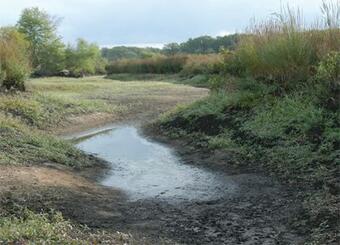The Influence of Climatic, Watershed, and Water-use Changes on Extreme Low Streamflows in the United States
Extreme low streamflows impact water availability for human systems and ecosystems. Numerous researchers have analyzed trends in low streamflows in the U.S. There is no known published work, however, on historical trends over time in the most extreme low streamflows—the flows with the largest impacts on human systems and ecosystems. The current study attempts to fill this gap. The wealth of historical U.S. Geological Survey streamflow, watershed, and water-use data across the country provides a great opportunity to better understand this critical issue.
Our Research: We aim to provide better understanding of the effect of historical climatic changes, human watershed changes (such as urbanization and reservoir storage), and water-use changes on extreme low flows in the United States.
Why this Research is Important: Hydrologic drought in the United States can have severe impacts on agriculture, municipal water supply, and ecosystems. It is important to know whether extreme low flows have been changing over time and why, to better inform future drought flows.

Objective(s):
- Hydrologic drought in the United States can have severe impacts on agriculture, municipal water supply, and ecosystems. It is important to know whether extreme low flows have been changing over time and why, to better inform future drought flows.
-
Identify the climatic influences and direct human influences on extreme low streamflows in the United States by examining trends and variability in extreme low streamflows for both least-disturbed and disturbed basins across the country.
-
Investigate the influence of winter and spring groundwater recharge on summer low streamflows.
Methods: Research continues with project collaborators to select the best statistical methods for each project objective.
Below are publications associated with this project.
Northeast
Climate-driven variability in the occurrence of major floods across North America and Europe
Framework for a hydrologic climate-response network in New England
The USGS National Streamflow Information Program and the importance of preserving long-term streamgages
The importance of record length in estimating the magnitude of climatic changes: an example using 175 years of lake ice-out dates in New England
Reference hydrologic networks II. Using reference hydrologic networks to assess climate-driven changes in streamflow
Reference hydrologic networks I. The status and potential future directions of national reference hydrologic networks for detecting trends
Relations between winter climatic variables and April streamflows in New England and implications for summer streamflows
Extreme events, trends, and variability in Northern Hemisphere lake-ice phenology (1855-2005)
Streamflow changes in Alaska between the cool phase (1947–1976) and the warm phase (1977–2006) of the Pacific Decadal Oscillation: The influence of glaciers
Changes in the timing of winter-spring streamflows in eastern North America, 1913-2002
Changes in late-winter snowpack depth, water equivalent, and density in Maine, 1926-2004
Below are news stories associated with this project.
Extreme low streamflows impact water availability for human systems and ecosystems. Numerous researchers have analyzed trends in low streamflows in the U.S. There is no known published work, however, on historical trends over time in the most extreme low streamflows—the flows with the largest impacts on human systems and ecosystems. The current study attempts to fill this gap. The wealth of historical U.S. Geological Survey streamflow, watershed, and water-use data across the country provides a great opportunity to better understand this critical issue.
Our Research: We aim to provide better understanding of the effect of historical climatic changes, human watershed changes (such as urbanization and reservoir storage), and water-use changes on extreme low flows in the United States.
Why this Research is Important: Hydrologic drought in the United States can have severe impacts on agriculture, municipal water supply, and ecosystems. It is important to know whether extreme low flows have been changing over time and why, to better inform future drought flows.

Objective(s):
- Hydrologic drought in the United States can have severe impacts on agriculture, municipal water supply, and ecosystems. It is important to know whether extreme low flows have been changing over time and why, to better inform future drought flows.
-
Identify the climatic influences and direct human influences on extreme low streamflows in the United States by examining trends and variability in extreme low streamflows for both least-disturbed and disturbed basins across the country.
-
Investigate the influence of winter and spring groundwater recharge on summer low streamflows.
Methods: Research continues with project collaborators to select the best statistical methods for each project objective.
Below are publications associated with this project.
Northeast
Climate-driven variability in the occurrence of major floods across North America and Europe
Framework for a hydrologic climate-response network in New England
The USGS National Streamflow Information Program and the importance of preserving long-term streamgages
The importance of record length in estimating the magnitude of climatic changes: an example using 175 years of lake ice-out dates in New England
Reference hydrologic networks II. Using reference hydrologic networks to assess climate-driven changes in streamflow
Reference hydrologic networks I. The status and potential future directions of national reference hydrologic networks for detecting trends
Relations between winter climatic variables and April streamflows in New England and implications for summer streamflows
Extreme events, trends, and variability in Northern Hemisphere lake-ice phenology (1855-2005)
Streamflow changes in Alaska between the cool phase (1947–1976) and the warm phase (1977–2006) of the Pacific Decadal Oscillation: The influence of glaciers
Changes in the timing of winter-spring streamflows in eastern North America, 1913-2002
Changes in late-winter snowpack depth, water equivalent, and density in Maine, 1926-2004
Below are news stories associated with this project.

